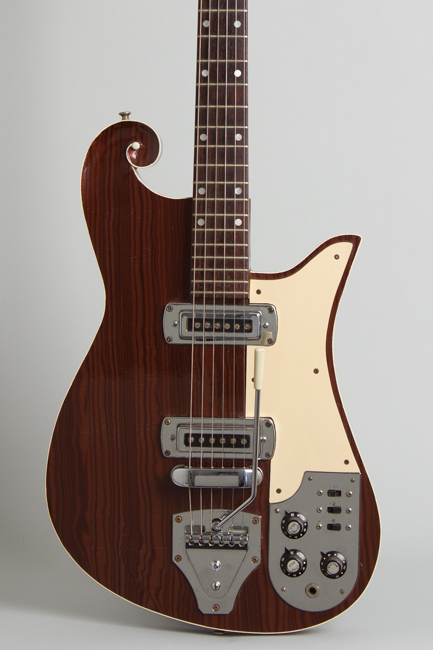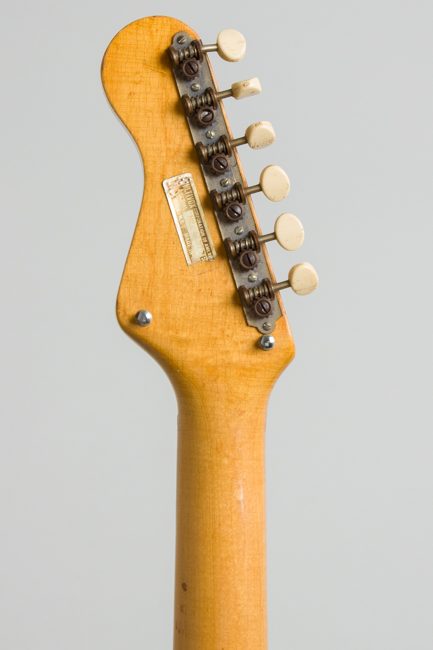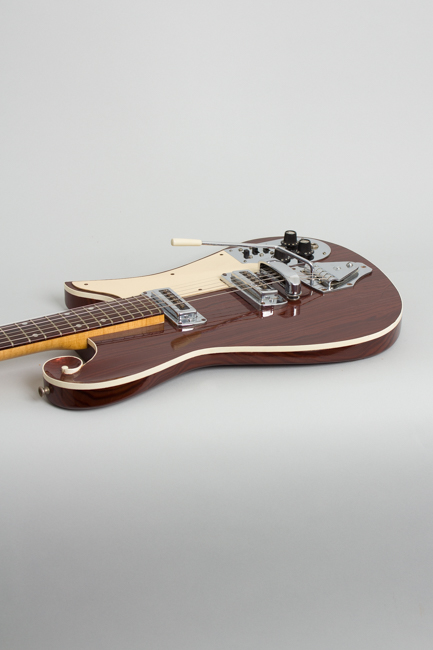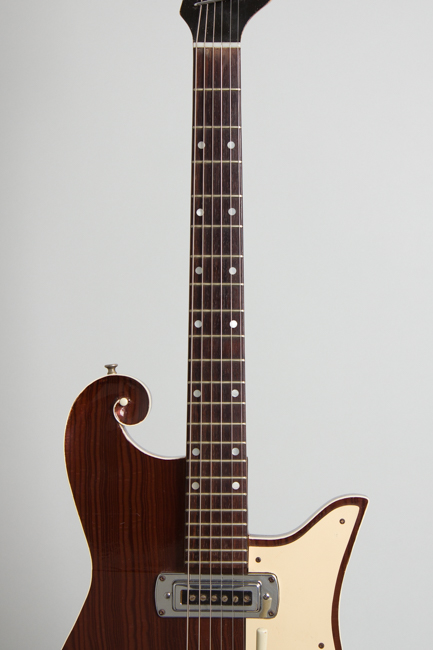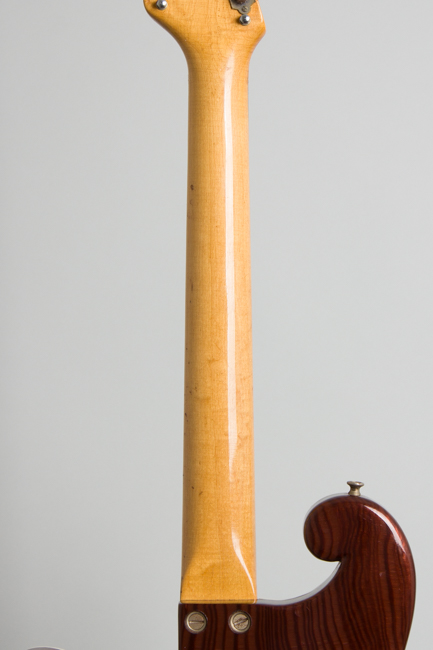Premier Model E-781 Solid Body Electric Guitar (1965)
Premier Model E-781 Model Solid Body Electric Guitar (1965), made in New York, NY, serial # 5778, woodgrain plastic finish, mahogany body, Brazilian rosewood neck, original black chipboard case.
This 1965 scroll-body Premier E-781 solidbody guitar is a very late example one of the coolest and quirkiest 6-strings to come out of the New York area. Although originally made in NYC of locally sourced parts, by the time this one was made these were a truly international guitars with American wood and tuners, Italian vibrato and bridge and Japanese pickups and electronics. These "scroll" guitars were originally pitched as professional quality instruments but by this point were pretty much garage band specials; they retained a distinctive look, at least.
The Peter Sorkin company was a well-established New York City jobber with several house brands, the flagship being Premier. 1950s Premier-branded amplifiers came in a variety of sizes and often eye-catching styles, and are still sought after today. These were built by Sorkin's satellite company Multivox; this guitars carries this name on the stamped metal-foil plaque on the back of the headstock. Numerous hollowbody guitars were offered under the Premier brand name in the 1950s, some were quite fancy often featuring distinct glitter trim.
Premier-branded solid-body guitars debuted in 1958, a quirky and original design with a unique look and feel. This 1965 example retains the most interesting element of the earlier models: the body with a Gibson-mandolinesque scroll carved into the upper bout, the cutaway below curving downward in a gentle arc. By the mid-60s the entire body was coated with sheet plastic, in a color Premier called "Custom Burl Walnut". This has a slightly 3-D look about it, another visual marvel of the vintage plastic maker's art. The top is bound into the scroll area with a celluloid dot in the center. The back is dressed away somewhat like a Stratocaster, making the guitar more comfortable to play. They were offered in several plastic-coated finish options at the time, including red and black.
The bolt-on maple neck has a very Fender-y headstock and an unbound, dot inlaid rosewood fingerboard. This has a chunky round-backed profile, substantial but still quite playable; there is no adjustable truss rod so the relative thickness was a good idea. The black-painted headstock is adorned with a stenciled Premier logo and fitted with openback Waverly strip tuners. The plastic-covered body is fitted with two single-coil pickups that look to have been sourced from either Fujigen Gakki or Kawai, with pots and Japanese wiring including a control panel featuring typical selector switches with pickup on/offs and a rhythm circuit. The vibrato and bridge are Italian made, although "Patented" is stamped into the plate in English.
These were not especially cheap guitars; this model was priced in 1965 at $179.50 which was less than the average pro-grade instrument but more than many beginner models. Within a year or so after this one was made the entire Premier guitar line vanished into the mists of guitar memory. Despite their local origins we rarely see these Premier solid-bodies, either the earlier 1950s or later '60s versions. This is the nicest example of a later "scroll guitar" we have had, all original and as good a player as they come.
Overall length is 38 1/2 in. (97.8 cm.), 13 in. (33 cm.) wide at lower bout, and 1 1/4 in. (3.2 cm.) in depth, measured at side of rim. Scale length is 24 3/4 in. (629 mm.). Width of nut is 1 5/8 in. (41 mm.).
This Premier is a nice all-original example; it has been played over the years and shows some light wear but nothing too distressing. The all-original finish (including the plastic body coating) shows scuffing, dings, and minor scratches overall with the heaviest wear to the headstock. The back of the body has some minor curly-cord burn marks, and the back of the neck has some small dings and chips but nothing too noticeable.
The hardware is all original and complete (including the bridge cover and trem arm) with general light wear; the top tuner shaft is bent a bit but still works fine. This is easily the best-playing of these we have seen with a nice straight neck and only some very light fret wear. The pickups have that "Teisco twang" with a raunchy twist when cranked, and in terms of sheer visuals this style Premier is always an eye-catcher. It resides in the original chipboard case. Overall Excellent - Condition.
This 1965 scroll-body Premier E-781 solidbody guitar is a very late example one of the coolest and quirkiest 6-strings to come out of the New York area. Although originally made in NYC of locally sourced parts, by the time this one was made these were a truly international guitars with American wood and tuners, Italian vibrato and bridge and Japanese pickups and electronics. These "scroll" guitars were originally pitched as professional quality instruments but by this point were pretty much garage band specials; they retained a distinctive look, at least.
The Peter Sorkin company was a well-established New York City jobber with several house brands, the flagship being Premier. 1950s Premier-branded amplifiers came in a variety of sizes and often eye-catching styles, and are still sought after today. These were built by Sorkin's satellite company Multivox; this guitars carries this name on the stamped metal-foil plaque on the back of the headstock. Numerous hollowbody guitars were offered under the Premier brand name in the 1950s, some were quite fancy often featuring distinct glitter trim.
Premier-branded solid-body guitars debuted in 1958, a quirky and original design with a unique look and feel. This 1965 example retains the most interesting element of the earlier models: the body with a Gibson-mandolinesque scroll carved into the upper bout, the cutaway below curving downward in a gentle arc. By the mid-60s the entire body was coated with sheet plastic, in a color Premier called "Custom Burl Walnut". This has a slightly 3-D look about it, another visual marvel of the vintage plastic maker's art. The top is bound into the scroll area with a celluloid dot in the center. The back is dressed away somewhat like a Stratocaster, making the guitar more comfortable to play. They were offered in several plastic-coated finish options at the time, including red and black.
The bolt-on maple neck has a very Fender-y headstock and an unbound, dot inlaid rosewood fingerboard. This has a chunky round-backed profile, substantial but still quite playable; there is no adjustable truss rod so the relative thickness was a good idea. The black-painted headstock is adorned with a stenciled Premier logo and fitted with openback Waverly strip tuners. The plastic-covered body is fitted with two single-coil pickups that look to have been sourced from either Fujigen Gakki or Kawai, with pots and Japanese wiring including a control panel featuring typical selector switches with pickup on/offs and a rhythm circuit. The vibrato and bridge are Italian made, although "Patented" is stamped into the plate in English.
These were not especially cheap guitars; this model was priced in 1965 at $179.50 which was less than the average pro-grade instrument but more than many beginner models. Within a year or so after this one was made the entire Premier guitar line vanished into the mists of guitar memory. Despite their local origins we rarely see these Premier solid-bodies, either the earlier 1950s or later '60s versions. This is the nicest example of a later "scroll guitar" we have had, all original and as good a player as they come.
Overall length is 38 1/2 in. (97.8 cm.), 13 in. (33 cm.) wide at lower bout, and 1 1/4 in. (3.2 cm.) in depth, measured at side of rim. Scale length is 24 3/4 in. (629 mm.). Width of nut is 1 5/8 in. (41 mm.).
This Premier is a nice all-original example; it has been played over the years and shows some light wear but nothing too distressing. The all-original finish (including the plastic body coating) shows scuffing, dings, and minor scratches overall with the heaviest wear to the headstock. The back of the body has some minor curly-cord burn marks, and the back of the neck has some small dings and chips but nothing too noticeable.
The hardware is all original and complete (including the bridge cover and trem arm) with general light wear; the top tuner shaft is bent a bit but still works fine. This is easily the best-playing of these we have seen with a nice straight neck and only some very light fret wear. The pickups have that "Teisco twang" with a raunchy twist when cranked, and in terms of sheer visuals this style Premier is always an eye-catcher. It resides in the original chipboard case. Overall Excellent - Condition.



